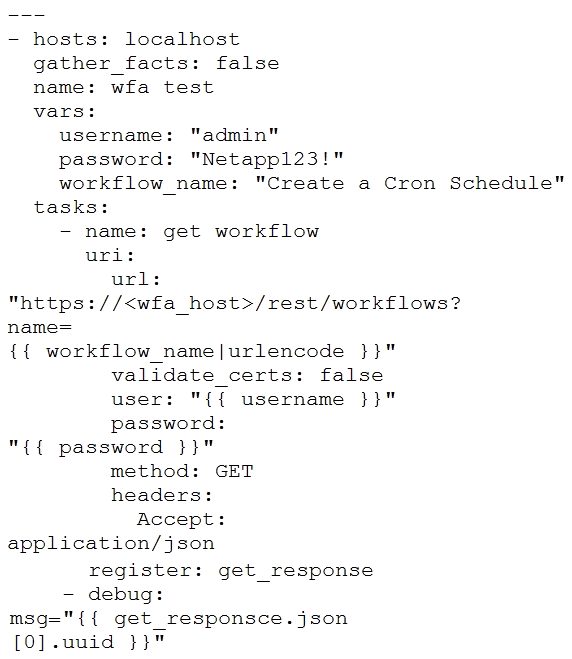NetApp Certified Hybrid Cloud Implementation Engineer - NCHCIE NS0-402 Exam Practice Test
You are sending API commands to NetApp Cloud Manager.
In this scenario, which type of authorization is used?
Answer : A
You are asked to design a Trident solution on NetApp ONTAP for a highly scaled Kubernetes environment that contains thousands of stateful microservice applications.
Which ONTAP Trident driver should be used in such a highly scaled environment?
Answer : C
You must have a firewall adjusted to allow Ansible to work with ONTAP and Element software.
In this scenario, which port must be allowed for both systems?
Answer : D
You have existing OnCommand Workflow Automation workflows. You are required to run these existing workflows in Ansible.

When you run the playbook that is shown in the exhibit, what is displayed?
Answer : C
A customer has implemented a NetApp-based hybrid cloud solution using AFF A700 on-premises and Cloud Volumes ONTAP for AWS. When attempting to cut over workloads from on-premises to AWS, a final SnapMirror update fails.
In this scenario, what are two validation points to ensure cutover success? (Choose two.)
Answer : B, C
You are writing a script to verify, update and display discrepancies of IT assets in the corporate content management database (CMDB). You must use the RESTful API to interface with the CMDB server.
What are two common formats for the RESTful API responses? (Choose two.)
Answer : B, C
Your company's infrastructure includes on-premises multivendor resources and public cloud Amazon Elastic Compute Cloud (Amazon EC2) instances on AWS. Your company is also planning on expanding its public cloud infrastructure to Azure and Google Cloud. You need to implement a tool to monitor the performance issues and errors for your entire environment, using real-time service-level indicators.
In this scenario, which tool should you implement to achieve this goal?
Answer : C